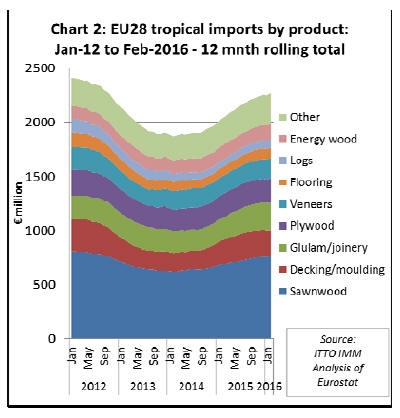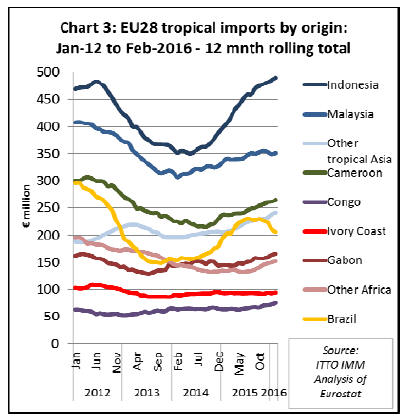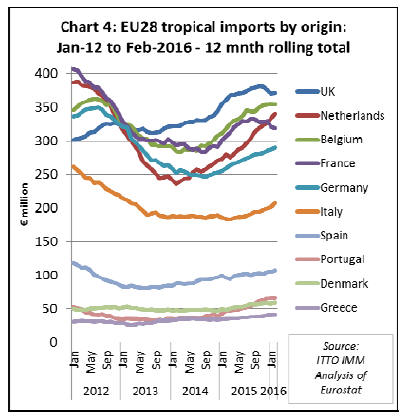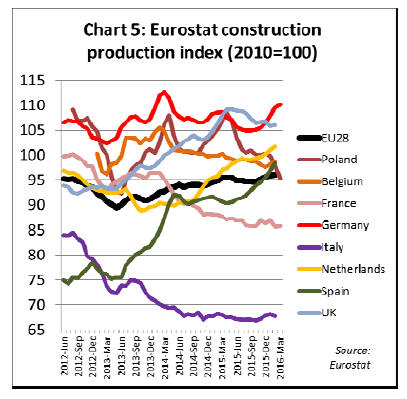|
Report from
Europe
Pace of EU tropical import growth slows in 2016
The latest trade data shows that the sharp rising trend in
EU import value of tropical wood products that began in
the second half of 2014 levelled off in the opening months
of this year. This was mainly due to slowing imports of
tropical sawn wood and decking, notably from Brazil.
Recent trends in the EU import trade should be viewed
against the background of the sharp fall in the value of the
euro against the dollar and other international currencies
between mid-2014 and early 2015. The euro has remained
relatively weak since then (Chart 1).
The higher value of EU imports in 2015 is due not only to
better consumption in the EU but also to rising euro prices
of imported products. Most exporters of wood products
into the EU will only have noted a relatively minor uptick
in the dollar value of sales to the region.

Charts 2 to 4 below show the monthly trend in imports of
tropical wood products into the EU to February 2016 using
12 month rolling totals. This is calculated for each month
as the total import of the previous 12 months.
The data removes short-term fluctuations due to seasonal
changes in supply and shipping schedules and provides a
clear indication of the underlying trade trend.
Chart 2 shows total EU Euro import value of all wood
products listed in Chapter 44 of the HS codes sourced
from tropical countries. Total imports in the 12 months to
February 2016 were Euro2.27 billion, which compares to
only Euro1.87 billion in the same month of 2014 when the
12 monthly total hit bottom in the wake of the euro-zone
crises.

The pace of the rebound in imports from that low
accelerated throughout 2014 and most of 2015,
particularly for sawn wood, decking/mouldings and
joinery products, but has levelled off this year.
Chart 3 shows how imports from the major supply
countries have developed during this period. The increase
in imports from Indonesia, now the EU¡¯s largest supplier
of tropical wood products by a significant margin, has
been particularly notable.
Indonesia has significantly outperformed other suppliers
and growth has continued into 2016.

Indonesia may be benefitting from efforts to develop and
expand SVLK, recently rewarded by the announcement
that the certification system is ready to become the first to
deliver FLEGT licenses into the EU market. When those
licenses are issued, expected later in 2016, all Indonesian
wood products sold into the EU will no longer be subject
to legality due diligence requirements.
The trade data suggests that even before that
announcement, Indonesia has been benefitting from the
added confidence associated with its domestic SVLK and
the commitment to long-term market development in the
EU that it implies.
The fortunes of other tropical suppliers in the EU market
have been mixed. Imports from Malaysia were rising
slowly throughout most of 2015, particularly benefitting
from better demand in the Netherlands, but have dipped
again in the opening months of 2016.
Imports from Brazil have been particularly volatile, rising
sharply in the first half of 2015 on the back of improved
French demand for sawn wood and decking, but falling
away again equally sharply in the second half of last year.
The downward trend in EU imports from Brazil has
continued into 2016.
The value of EU imports from Cameroon has risen quite
steeply and consistently since the low in summer 2014, but
still remains well below the level of 2012 and is now little
more than half that of Indonesia.
Imports from Gabon and Congo Republic have continued
to rise slowly while imports from Ivory Coast have been
flat at a low level.
Chart 4 shows how the value of tropical wood imports into
the main EU consuming countries has developed
throughout the last 4 years. The UK has been the largest
EU market for tropical wood since the start of 2013 when
demand fell sharply in the euro-zone countries. Imports
into the UK fell less sharply and began to rise earlier than
into other European countries hitting a peak in the third
quarter of 2015. However UK imports have dipped again
since then.

Chart 1 suggests that exchange rates may have been an
important factor driving this trend. The dollar exchange
rate of the British pound remained stronger than that of the
euro throughout 2014 and 2015 but the rate has been
sliding since the third quarter of 2015.
Belgium and the Netherlands are currently the second and
third largest destinations for tropical wood imported into
the EU respectively. The euro value of imports into both
countries increased sharply in 2015. The pace of growth
slowed into Belgium in the first two months of 2016 but
remained high into the Netherlands.
Recent growth in imports is partly owing to the role of
large Belgian and Dutch distributors in supply to other
parts of the continent.
The long term trends towards greater just-in-time trading
of smaller mixed consignments, together with EUTR
which has discouraged smaller operators to buy direct, has
tended to increase the role of larger distributors in
Belgium and the Netherlands. Domestic consumption is
also rising, particularly in the Netherlands where
construction sector activity continues to recover strongly.
Recent trends in the French tropical wood import trade
have been heavily influenced by trade with Brazil. After
importing very little from Brazil in 2013 and 2014, French
imports of joinery and decking timbers from the South
American country increased sharply in early 2015 before
falling to a low level in September last year where they
have remained ever since.
French imports from African countries, led by Gabon and
Cameroon, were rising slowly in the twelve months to
February 2016.
Tropical wood imports into all other leading EU markets -
including Germany, Italy, Spain, Portugal, Denmark and
Greece - were also rising consistently in the 12 months to
February 2016.
In Italy, the upward trend began later than elsewhere in
Europe but picked up pace in the opening months of 2016,
an encouraging trend in a traditionally large tropical
timber consuming country which has suffered a
particularly deep and protracted downturn.
Upturn in EU construction sector activity
The Eurostat Construction Production Index shows that
EU construction sector activity turned upward in the last
quarter of 2015 and the rising trend continued into the first
quarter of 2016.
Strong growth in activity in Germany, Netherlands, and
Spain offset weakening activity in the UK and Poland.
Activity in France and Belgium remained flat during this
period. Activity in Italy remains at a very low level but
there were some minor gains in the last quarter of 2016
(Chart 5).

Further insight into the EU construction market is
provided by the 2015 European Architectural Barometer
report published by independent research agency Archvision
in March 2016 based on a survey of 1,600 architects
in eight European countries.
The order books, turnover and perceptions of European
architects provide a leading indicator for construction
activity. The survey indicates slow but consistent growth
in European construction activity in 2015 with faster
recovery expected in 2016 and 2017.
Key conclusions for each of the eight countries are as
follows:
 Construction activity in Belgium
has been Construction activity in Belgium
has been
improving slowly and consistently since the end
of 2014. Architects order books and turnover
were higher in 2015 than in 2014. Building
permits for both residential and non-residential
construction increased in 2015 after falling in
2014. The construction confidence indicator
improved in the last quarter of 2015. Achi-Vision
forecasts solid growth in Belgian construction
activity of 2% in 2016, a rate expected to
continue into 2017.
 In France the construction sector
is still in In France the construction sector
is still in
recession but slowly improving. In the last
quarter of 2015 architects order books grew for
the first time since the first quarter of 2011.
Architects turnover is also stabilizing. The
Eurostat construction confidence and building
permits indicators have improved slightly. Arch-
Vision predict that construction activity in France
will decline 2% in 2016 before stabilising in 2017
and recovery from 2018 onwards.
 In Germany, confidence amongst
architects has In Germany, confidence amongst
architects has
been rising steadily over the last 4 years against a
background of gradually improving order books.
The level of building permits for both residential
and non-residential construction was very stable
throughout the years 2014 and 2015 suggesting
continuing improvement. There is good demand
for housing and macroeconomic forecasts are
quite positive. But while construction confidence
is increasing, confidence in other industry sectors
and amongst consumers is lagging in Germany.
Arch-Vision expects 2% growth in German
construction in 2016.
 The construction market in Italy
remains the The construction market in Italy
remains the
worst performing in Europe, although it is
beginning to stabilise and should start to recover
in 2017. Architects order books and turnover
continue to decline but the rate of fall slowed in
the second half of 2015. Building permits and
construction confidence indicators are declining
but at a slower rate. Arch-Vision predicts a
further 2% decline Italian construction activity in
2016 with the possibility of stabilisation in 2017.
 The Netherlands construction sector
grew more The Netherlands construction sector
grew more
rapidly than elsewhere in Europe in 2015 and
growth is expected to remain at a high pace in
2016 and 2017. Dutch architects¡¯ order books and
turnover are at their highest level since 2011. The
Eurostat construction confidence indicator
increased rapidly and continuously between the
end of 2012 and end of 2015. However it
stumbled a little at the end of last year on news of
a decrease for in building permits for both
residential and non-residential construction.
Nevertheless Arch-Vision predicts that
construction activity will increase 4% in 2016
and that this rate will continue or even strengthen
in 2017.
 Construction activity in Poland,
the largest Construction activity in Poland,
the largest
Eastern European economy, remains relatively
high. The Eurostat construction production index
suggests some decline in construction activity in
the last three quarters of 2015, a trend which
continued into the first quarter of 2016. However
according to Arch-Vision, architects order books
and turnover have continued to rise slowly
throughout this period. Arch-Vision expects
Polish construction activity to expand 2% in 2016
and this rate to be maintained in 2017.
 Although still well below
pre-crises levels, Although still well below
pre-crises levels,
construction activity in Spain continues to
recover. Architects order books and turnover
were rising in the last quarter of 2015. Despite
some fluctuation, residential building permits
seem to be slowly recovering while permits for
non-residential construction increased rapidly in
2015. The Eurostat construction confidence
indicator is still in negative territory and fell at
the beginning of 2016, but after big gains in 2015
is still significantly higher than two years ago.
Arch-Vision predict 4% growth in Spanish
construction activity in 2016, possibly rising to
5% in 2017.
 The UK construction market
continues to The UK construction market
continues to
improve but the increase has become less
consistent. Building permits for new residential
construction were rising in 2014 and the first
quarter of 2015 but weakened in the second half
of the year. Confidence indicators have also been
more variable in the UK. Nevertheless confidence
within architectural firms was still good in the
last quarter of 2015 and order books and turnover
development was quite positive. The latest British
Woodworking Federation quarterly report
showed that while the first quarter of 2016 was a
testing time for many joinery manufacturers,
most were confident of rising sales in the second
quarter. Arch-Vision predicts growth of the
overall UK construction market of 3% in 2016.
|